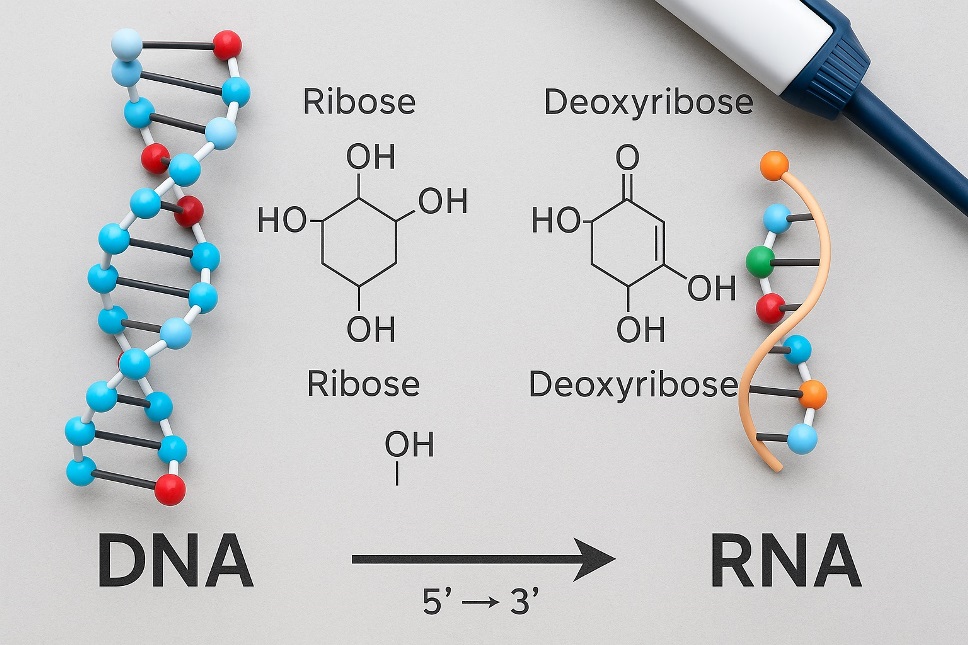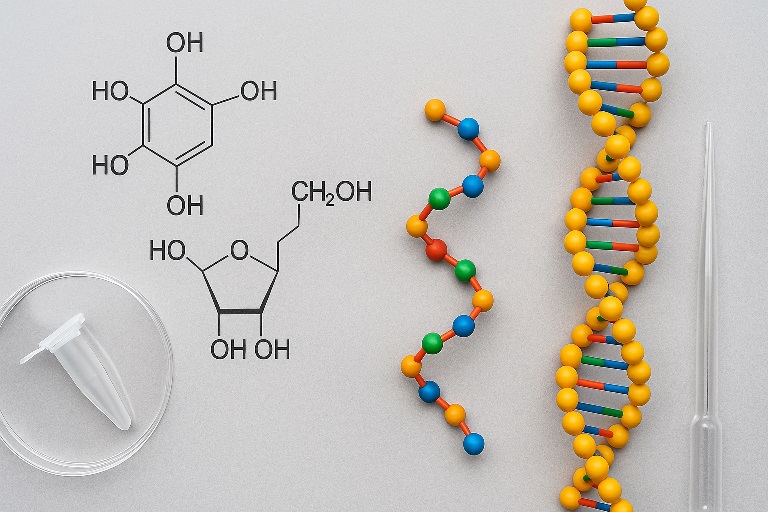
Understanding the dna vs rna comparison is one of the cornerstones of molecular biology. These two nucleic acids carry the information of life and drive the processes that keep cells alive. While they share some similarities, their differences in structure and function shape everything from genetic stability to protein creation. By exploring five crucial contrasts, you’ll gain clarity on how DNA and RNA work individually and together to support life.
1. Sugar Backbone and Chemical Structure

One of the most obvious distinctions is in their sugar backbone. DNA contains deoxyribose, a sugar molecule missing one oxygen atom, while RNA contains ribose. This small chemical shift, often referred to as ribose vs deoxyribose, makes RNA chemically less stable and more reactive than DNA.
The sugar type directly impacts overall RNA structure. The extra hydroxyl group in ribose allows RNA strands to fold into complex shapes, including loops and hairpins, which contribute to its wide range of functions. DNA, on the other hand, maintains a consistent double helix structure that provides long-term stability and storage of genetic information.
2. Base Composition and Pairing

Another essential difference between dna and rna lies in their nitrogenous bases. DNA uses adenine (A), guanine (G), cytosine (C), and thymine (T). RNA replaces thymine with uracil (U). This seemingly small variation has major biological implications.
The nucleotide pairing rules are also slightly different. Adenine and thymine always form a pair, just as guanine and cytosine do, within the structure of DNA. In RNA, adenine pairs with uracil. This substitution influences the way RNA transcripts are read and how proteins are built, adding flexibility but also reducing long-term stability compared to DNA.
3. Strand Structure and Location in the Cell
DNA exists primarily as a long, double-stranded molecule stored in the nucleus of eukaryotic cells. Its coiled double helix form ensures durability and ease of replication. By contrast, RNA is usually single-stranded, allowing it to fold and act in diverse cellular processes.
The location in cell also differs. DNA remains protected inside the nucleus, with small amounts in organelles like mitochondria. RNA, however, travels: it is synthesized in the nucleus but performs many of its functions in the cytoplasm, ribosomes, or even within organelles. This mobility highlights the cooperative roles of dna and rna in gene expression.
4. Function in Genetic Processes
The primary role of DNA is to store the genetic code. It acts as the permanent library of instructions for growth, development, and reproduction. RNA, in contrast, plays active roles in carrying out these instructions.
Different types of RNA serve unique purposes:
- Messenger RNA (mRNA) carries DNA’s information to ribosomes.
- Ribosomal RNA (rRNA) helps form the ribosome machinery.
- Transfer RNA (tRNA) delivers amino acids for protein chains.
Together, these molecules are essential for protein synthesis, which converts DNA instructions into functional proteins. The processes of transcription vs translation show this partnership: transcription copies DNA into RNA, while translation reads RNA to build proteins. This difference in functionality underscores the many differences between dna and rna.
Also Read: Prokaryotes vs Eukaryotes: Cell Types Compared & Explained
5. Stability, Lifespan, and Repair
Finally, the contrast in stability defines much of the distinction. The stability of DNA is unparalleled. Its double helix protects it, and cells possess advanced DNA repair mechanisms to maintain its integrity over generations. This makes DNA an ideal long-term storage molecule.
RNA, however, is temporary. Its chemical structure and exposed single strand mean it is degraded quickly once its job is done. This transience ensures that instructions are used only when needed, keeping cellular processes efficient and controlled.
The dynamic between permanence and flexibility illustrates why DNA secures the blueprint of life while RNA executes short-lived, precise tasks. This practical balance is a foundation of molecular biology basics.
Conclusion
Exploring these five areas—sugar chemistry, bases, strand structure, function, and stability—makes the rna vs dna debate crystal clear. DNA is the stable archive of hereditary instructions, while RNA is the versatile worker, turning instructions into reality. Their partnership explains everything from how cells divide to how vaccines are designed.
Understanding the dna vs rna comparison not only enhances basic knowledge but also connects to real-world applications in biotechnology, medicine, and genetics. Once these differences are mastered, learners can more easily appreciate fields like genome sequencing, RNA therapeutics, and modern diagnostics.
FAQs
1. Why is RNA less stable than DNA?
RNA’s ribose sugar has an extra hydroxyl group that makes it more reactive and prone to breakdown, while DNA’s structure is chemically more stable.
2. How does RNA contribute to protein synthesis?
RNA carries the message from DNA, brings amino acids, and forms ribosomal components, all of which are essential for building proteins.
3. What role does DNA repair play in genetics?
DNA repair mechanisms correct damage or mutations, protecting the integrity of genetic information and reducing the risk of harmful changes.
4. Why does RNA use uracil instead of thymine?
Uracil is metabolically cheaper to produce, and since RNA is short-lived, the long-term stability provided by thymine is unnecessary.
5. Where do DNA and RNA interact in the cell?
DNA stays in the nucleus, while RNA is transcribed there and then functions in the cytoplasm and ribosomes to help build proteins.